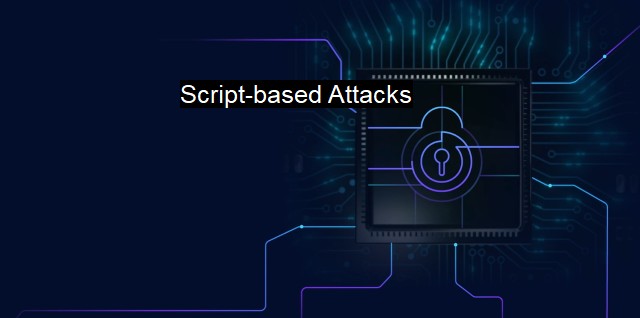What are Script-based Attacks?
Script-Based Attacks: The Emerging Cybersecurity Threat Lurking in the Shadows
Script-based attacks or script-based vulnerabilities refer to specific types of cyber threats that involve malicious software codes or scripts to exploit vulnerabilities in a system or network and carry out malicious activities. These attacks can lead to a wide range of security threats, including unauthorized data access, data theft, data corruption, system tampering, and other significant damages.With an attacker can launch a script-based attack in various ways. This could be through a seemingly harmless email attachment that carries an embedded script, or through 'drive-by downloads' where scripts run automatically when an unsuspecting user visits a compromised website.
While traditionally, experienced malicious hackers wrote script-based codes manually, nowadays, numerous easily available script-generating tools and software aid inexperienced hackers to assemble their malicious scripts.
One notable factor of script-based attacks is their potential for massive scalability. A single successful attack format can automate hacking, spreading rapidly across networks and deploying the malicious script on many systems simultaneously.
What makes script-based attacks so powerful and dangerous is their ability to control or manipulate targeted systems indirectly. Attackers infiltrate the system by embedding the script into routine and innocuous-looking system operations that users or machines perform in their daily use. When such activities occur, the hidden scripts are set off, deploying the malicious action without the system's defense mechanisms noticing.
In the case of phishing attacks or cross-site scripting (XSS), malicious scripts are embedded within emails or webpages. Users get entrapped when they innocently open the email or visit the webpage, thereby activating the hidden scripts.
Adding to the threat is the fact that attack scripts can be coded in various languages such as JavaScript, VBScript, or PowerShell, each bringing unique opportunities for exploiting different system vulnerabilities. PowerShell scripting, for instance, is highly favored by many attackers due to its deep integration into the Windows operating system, making it more challenging for antivirus software to detect and stop these scripts.
In terms of mitigating script-based attacks, most traditional antivirus solutions and security measures find it challenging to counteract them due to their low visibility and high stealth nature.
Traditional antivirus solutions typically rely on signature-based detection methods to identify viruses or malicious activities. these do not work efficiently against script-based attacks mainly because scripts do not require file downloads to execute. They can be run directly within the application, be it a web-browser, email client, or a document reader, thereby bypassing signature-based recognition.
The obfuscation techniques that these attacks employ can confuse antivirus programs. Instead of using known malicious software or virus signatures, these scripts utilize legitimate system functionalities invisibly to carry out their harmful activities.
Despite these obstacles, cybersecurity professionals have been developing and introducing countermeasures over the years. Behavioral-based detection and blocking, for instance, monitors system behaviors to flag and stop suspicious scripting activity bypassing traditional detection means. Another solution is the ‘sandboxing’ technique, where suspect files or scripts get isolated in a virtual environment for risk evaluation.
Advanced threat detection systems making use of Machine Learning (ML) and Artificial Intelligence (AI) techniques are also increasingly being utilized for early detection and mitigation of script-based attacks.
Script-based attacks pose a significant threat in the realm of cybersecurity. Preying on human behaviors and system vulnerabilities, these alterations stealthily bypass traditional security measures to inflict serious damage. with evolving defensive measures and heightened awareness, businesses and individual users can better prepare themselves for these threats and create a safer cyber world.

Script-based Attacks FAQs
What are script-based attacks?
Script-based attacks are cyber attacks that use scripts or programming languages to exploit vulnerabilities in software. These attacks can be initiated through web pages, emails, or other means and can result in theft of sensitive information, installation of malware, or other malicious activities.How do script-based attacks work?
Script-based attacks typically involve a cyber criminal finding a weakness in a software program and then creating a script or code that exploits that vulnerability. Once the script is executed, it can carry out a range of malicious activities, such as stealing data, hijacking a system or installing malware.How can I protect myself from script-based attacks?
To protect yourself from script-based attacks, you should ensure that your antivirus software is up-to-date and that your web browser and operating system have the latest security patches installed. Additionally, avoid clicking on suspicious links or opening attachments from unknown senders and use caution when downloading software or using unfamiliar applications.What are some examples of script-based attacks?
Some examples of script-based attacks include cross-site scripting (XSS), SQL injection, and phishing scams that use JavaScript to download malware or steal login credentials. These attacks can be highly sophisticated, and it's important to be aware of the different types of attacks so you can take appropriate precautions to protect yourself and your data.| | A | | | B | | | C | | | D | | | E | | | F | | | G | | | H | | | I | | | J | | | K | | | L | | | M | |
| | N | | | O | | | P | | | Q | | | R | | | S | | | T | | | U | | | V | | | W | | | X | | | Y | | | Z | |
| | 1 | | | 2 | | | 3 | | | 4 | | | 7 | | | 8 | | |||||||